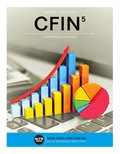
EBK CFIN
5th Edition
ISBN: 9781305888036
Author: BESLEY
Publisher: CENGAGE LEARNING - CONSIGNMENT
expand_more
expand_more
format_list_bulleted
Question
Chapter 8, Problem 16PROB
Summary Introduction
Here,
The cost of equity or required rate of return is “r”.
The risk-free rate is “
The risk premium is “
The market return is “
The beta coefficient is “
The expected market return is 12.5%, required rate of return is 11%, and beta coefficient is 0.8.
Expert Solution & Answer
Want to see the full answer?
Check out a sample textbook solution
Students have asked these similar questions
What are the obstacles to work through emotional wellness coping methods, and increasing self-understanding, and how to work through them?
What are the advantages and disadvantages of emotional wellness, coping methods, and increasing self-understanding?
What is the present value of $10,000 to be received in 5 years, assuming a discount rate of 10%?A) $6,210B) $6,810C) $7,580D) $8,100
Depreciation is:a) The increase in the value of an asset over time.b) The allocation of the cost of a tangible asset over its useful life.c) An amount paid for the maintenance of an asset.d) An asset's market value at the end of the accounting period.
Knowledge Booster
Similar questions
- Depreciation is:a) The increase in the value of an asset over time.b) The allocation of the cost of a tangible asset over its useful life.c) An amount paid for the maintenance of an asset.d) An asset's market value at the end of the accounting period. Need helparrow_forwardWhat is the corporate finance how this is the part of finance?arrow_forwardExplain! Which of the following represents the primary goal of financial management?A) Maximizing net incomeB) Maximizing shareholder wealthC) Minimizing costsD) Maximizing market sharearrow_forward
- Which of the following represents the primary goal of financial management?A) Maximizing net incomeB) Maximizing shareholder wealthC) Minimizing costsD) Maximizing market sharearrow_forwardExplain! Which of the following is an example of a capital budgeting decision?A) Determining how to finance a new projectB) Deciding whether to pay dividends to shareholdersC) Deciding whether to purchase a new piece of equipmentD) Managing the company's cash balancesarrow_forwardExplain What does a beta coefficient of 1.5 indicate for a stock?A) The stock is less volatile than the marketB) The stock has no correlation with the marketC) The stock is 50% more volatile than the marketD) The stock is 50% less volatile than the marketarrow_forward
- What does a beta coefficient of 1.5 indicate for a stock?A) The stock is less volatile than the marketB) The stock has no correlation with the marketC) The stock is 50% more volatile than the marketD) The stock is 50% less volatile than the marketarrow_forwardWhat is the formula for calculating the net present value (NPV) of an investment?A) Future Cash Flows × Discount RateB) Present Value of Cash Inflows - Initial InvestmentC) Internal Rate of Return - Discount RateD) Net Income / Initial Investmentarrow_forwardWhich of the following is an example of a capital budgeting decision?A) Determining how to finance a new projectB) Deciding whether to pay dividends to shareholdersC) Deciding whether to purchase a new piece of equipmentD) Managing the company's cash balancesarrow_forward
- What is the formula for the current ratio?A) Current Assets / Total LiabilitiesB) Current Liabilities / Total AssetsC) Current Assets / Current LiabilitiesD) Total Assets / Current Liabilitiesarrow_forwardWhat is the primary goal of financial management?A) To maximize profitsB) To maximize shareholder wealthC) To minimize costsD) To maximize market sharearrow_forwardWhat is thr finance ? tell me more about corporate finance.arrow_forward
arrow_back_ios
SEE MORE QUESTIONS
arrow_forward_ios
Recommended textbooks for you
 Intermediate Financial Management (MindTap Course...FinanceISBN:9781337395083Author:Eugene F. Brigham, Phillip R. DavesPublisher:Cengage Learning
Intermediate Financial Management (MindTap Course...FinanceISBN:9781337395083Author:Eugene F. Brigham, Phillip R. DavesPublisher:Cengage Learning

Intermediate Financial Management (MindTap Course...
Finance
ISBN:9781337395083
Author:Eugene F. Brigham, Phillip R. Daves
Publisher:Cengage Learning